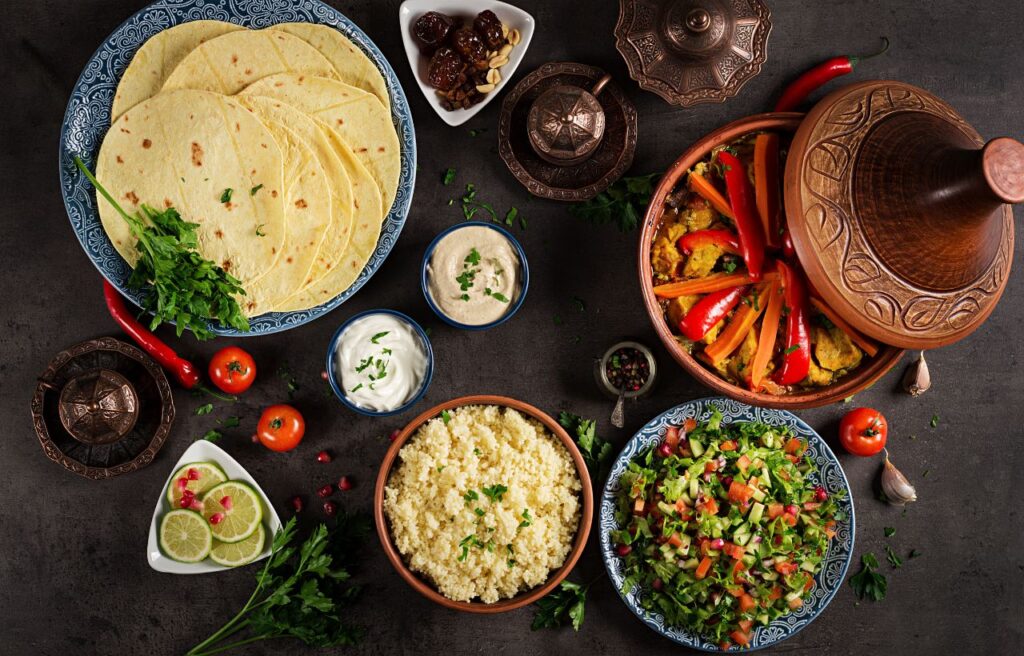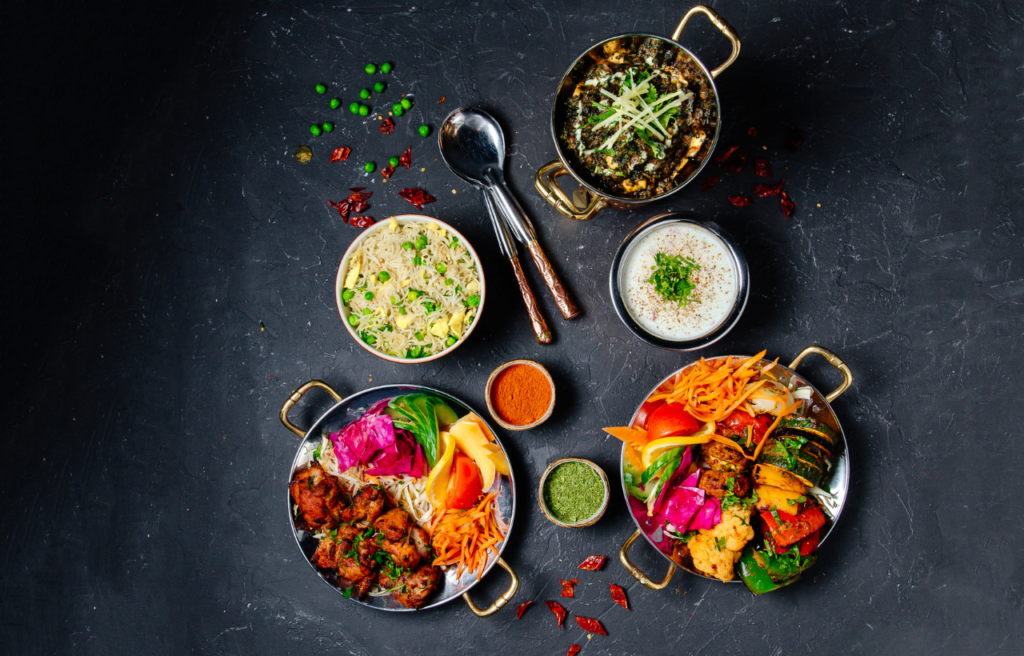African cuisine is a vast and diverse culinary landscape that reflects the continent’s rich cultural heritage, varied geography, and abundant natural resources. With over 54 countries and thousands of ethnic groups, the flavors, ingredients, and cooking techniques used in African cuisine vary significantly from region to region. This guide will introduce you to the unique flavors, ingredients, and cooking techniques that define the diverse cuisines of Africa.
Table of Contents
Regional African Cuisines
African cuisine can be broadly categorized into four main regions: North Africa, West Africa, East Africa, and Southern Africa. Each region boasts its unique culinary traditions, influenced by local ingredients, climate, and historical factors.
North African Cuisine
North African cuisine is characterized by the flavors and ingredients from countries such as Morocco, Algeria, Tunisia, Libya, and Egypt. Strongly influenced by Mediterranean, Arab, and Berber cultures, this cuisine features an abundance of spices, fresh herbs, and aromatic ingredients.
Key ingredients: Couscous, bulgur, lentils, chickpeas, olives, preserved lemons, and a wide variety of spices like cumin, coriander, saffron, and cinnamon.
Popular dishes: Tagine, couscous, shakshuka, baba ganoush, and harira.
West African Cuisine
West African cuisine, encompassing countries like Nigeria, Ghana, Senegal, and Mali, is known for its hearty stews, vibrant flavors, and the widespread use of grains, legumes, and tubers. This cuisine often incorporates a variety of proteins, including fish, poultry, and meat.
Key ingredients: Rice, millet, sorghum, cassava, yams, plantains, okra, tomatoes, onions, and spices like ginger, alligator pepper, and West African pepper.
Popular dishes: Jollof rice, fufu, egusi soup, groundnut stew, and suya.
East African Cuisine
East African cuisine, found in countries like Kenya, Tanzania, Ethiopia, and Uganda, features a diverse range of ingredients and flavors, heavily influenced by the region’s geography, including the Indian Ocean coastline and the Great Rift Valley.
Key ingredients: Maize, millet, sorghum, teff, lentils, injera (a sourdough flatbread), and spices like berbere, cardamom, and fenugreek.
Popular dishes: Doro wat, injera, ugali, nyama choma, and chapati.
Southern African Cuisine
Southern African cuisine, from countries like South Africa, Zimbabwe, Zambia, and Botswana, showcases a fusion of indigenous, European, and Asian influences. This cuisine often features locally sourced meats, grains, and vegetables.
Key ingredients: Maize, sorghum, samp (coarsely ground maize), beans, pumpkins, spinach, and fruits like apples, pears, and grapes.
Popular dishes: Bobotie, potjiekos, sadza, biltong, and chakalaka.

Cooking Techniques
African cuisine employs a variety of cooking techniques, ranging from slow-cooking and stewing to grilling and frying. Some common methods include:
- Stewing: Slow-cooking ingredients in liquid, often used for preparing tagines, soups, and stews.
- Grilling: Cooking food over an open flame, commonly used for preparing meats like suya and nyama choma.
- Frying: Cooking food in hot oil, used for dishes like plantains, samosas, and puff-puffs.
- Steaming: Cooking food with steam, often used for preparing couscous, tamales, and various types of bread, such as injera and chapati.
- Roasting: Cooking food in an oven or over an open flame, often used for dishes like whole fish or roasted vegetables.
- Smoking: Preserving and flavoring food by exposing it to smoke, a technique commonly used for preserving meats, such as biltong and suya.
- Fermenting: Allowing food to undergo controlled microbial growth to develop unique flavors, textures, and nutritional properties, often used for producing injera, sourdough flatbread, and various traditional beverages.
Key Spices and Flavors

Spices play a crucial role in African cuisine, contributing to the rich and diverse flavors that define the continent’s culinary landscape. Some of the most prominent spices used across various regions include:
- Berbere: A fiery Ethiopian spice blend made from chili peppers, garlic, ginger, fenugreek, and other spices.
- Ras el hanout: A North African spice blend that includes ingredients like cumin, coriander, cinnamon, ginger, and cardamom, often used in tagines and stews.
- Alligator pepper: A West African spice with a pungent, peppery flavor, often used in soups, stews, and rice dishes.
- Cardamom: A fragrant spice commonly used in East African and North African dishes, such as coffee, rice, and various desserts.
- Tamarind: A sour fruit used in various African dishes to add tanginess and depth of flavor, often found in chutneys, sauces, and soups.
Staple Ingredients
African cuisine relies on a variety of staple ingredients that form the foundation of many traditional dishes. Some of the most common staple ingredients include:
- Grains: Maize, millet, sorghum, teff, and rice are essential to African cuisine and are used to prepare a wide range of dishes like porridges, bread, and stews.
- Tubers: Yams, cassava, and sweet potatoes are key sources of carbohydrates in many African diets and are often used in soups, stews, and side dishes.
- Legumes: Beans, lentils, chickpeas, and peanuts provide essential protein and are widely used in stews, salads, and sauces.
- Vegetables: Tomatoes, onions, okra, spinach, and kale are common vegetables used across the continent, adding flavor, color, and nutrition to various dishes.
- Fruits: Plantains, bananas, mangoes, and pineapples are popular fruits in African cuisine, often used in desserts, salads, and sauces.
By exploring the diverse flavors, ingredients, and cooking techniques that define African cuisine, you can embark on a culinary journey that showcases the rich and vibrant culinary traditions of this vast continent. With such a wide variety of dishes and flavors to choose from, there is sure to be something to suit every palate.
Unique Cooking Utensils and Tools
African cuisine also features various unique cooking utensils and tools that have been used for generations, allowing for the preparation of traditional dishes. Some of these include:
- Tagine: A North African earthenware pot with a conical lid, used for slow-cooking stews and braises, allowing the flavors to meld and the ingredients to become tender.
- Mortar and Pestle: A tool used across the continent to grind spices, herbs, and grains, as well as to prepare various pastes and sauces.
- Injera Grill (Mitad): A large, round, electric or clay griddle used in East African cooking, primarily for making injera, a sourdough flatbread that serves as a staple food in Ethiopia and Eritrea.
- Calabash: A large, hard-shelled gourd that is hollowed out and used as a container, bowl, or serving utensil in many African cultures.
- Palm Nut Crusher: A wooden tool used in West Africa to crush palm nuts, extracting the oil for use in traditional dishes such as soups and stews.

Signature Dishes and Recipes
Each region in Africa has its own set of signature dishes that showcase the unique flavors and ingredients of the area. Here are a few examples of some of the most popular dishes from different regions:
North Africa
- Tagine: A slow-cooked stew or braise made with meat, poultry, fish, or vegetables, cooked in a traditional earthenware pot with a conical lid. Tagines often feature a combination of sweet and savory flavors, with ingredients like dried fruits, olives, and preserved lemons.
- Couscous: A staple dish made from steamed semolina grains, often served with vegetables, meat, or fish, and flavored with a variety of herbs and spices.
- Shakshuka: A popular North African and Middle Eastern dish consisting of poached eggs in a spicy tomato sauce, typically seasoned with cumin, paprika, and chili peppers.
West Africa
- Jollof Rice: A one-pot rice dish made with tomatoes, onions, bell peppers, and various spices, often served with chicken, fish, or vegetables. Jollof rice is a popular dish in many West African countries, including Nigeria, Ghana, and Senegal.
- Fufu: A starchy side dish made from boiled and pounded yams, cassava, or plantains, often served with soups and stews.
- Groundnut Stew: A rich and flavorful stew made with peanuts (groundnuts), tomatoes, and various vegetables, often accompanied by chicken, fish, or meat.
East Africa
- Injera with Doro Wat: Injera is a sourdough flatbread made from teff flour, commonly used in Ethiopian and Eritrean cuisine. Doro wat is a spicy, slow-cooked chicken stew, typically served on top of injera.
- Ugali: A staple dish in many East African countries, ugali is a dense, starchy side dish made from maize, millet, or sorghum flour. It is often served with meat, fish, or vegetables.
- Nyama Choma: A popular Kenyan and Tanzanian dish consisting of grilled or roasted meat, often served with a side of vegetables or starch, such as ugali or rice.
Southern Africa
- Bobotie: A South African dish made from spiced ground meat, chutney, and a custard-like topping, often served with yellow rice and vegetables.
- Potjiekos: A traditional South African stew cooked in a cast-iron pot over an open fire. Potjiekos typically includes a variety of meat, vegetables, and sometimes rice or potatoes, slow-cooked to allow the flavors to meld together.
- Biltong: A South African snack made from air-dried, cured meat, often seasoned with spices like coriander, allspice, and black pepper. Biltong is similar to beef jerky but has a distinct flavor profile and texture.
These are just a few examples of the many delicious and diverse dishes found in African cuisine. Each region has its own unique culinary traditions, influenced by local ingredients, climate, and historical factors, resulting in a wide variety of flavors and dishes to explore and enjoy.

Frequently Asked Questions About African Cuisine
- What are the most common ingredients in African cuisine?
African cuisine relies on a variety of staple ingredients, including grains (such as maize, millet, sorghum, teff, and rice), tubers (such as yams, cassava, and sweet potatoes), legumes (such as beans, lentils, chickpeas, and peanuts), vegetables (such as tomatoes, onions, okra, spinach, and kale), and fruits (such as plantains, bananas, mangoes, and pineapples).
- Which spices are commonly used in African dishes?
Spices play a crucial role in African cuisine, contributing to the rich and diverse flavors that define the continent’s culinary landscape. Some of the most prominent spices used across various regions include berbere, ras el hanout, alligator pepper, cardamom, and tamarind.
- Are there any common cooking techniques used in African cuisine?
African cuisine features a variety of cooking techniques, such as stewing, grilling, roasting, smoking, and fermenting. These techniques vary across regions and are influenced by local traditions, ingredients, and cultural practices.
- Is African cuisine generally spicy?
The spiciness of African cuisine varies greatly depending on the region and specific dish. While some dishes, particularly from regions like Ethiopia and West Africa, can be quite spicy, there are many dishes that are mild or only moderately spiced. It is essential to remember that African cuisine is diverse, and the level of spiciness in dishes can be easily adjusted to suit individual preferences.
- What are some popular African beverages?
African beverages vary by region and can include traditional teas (such as Moroccan mint tea and Somali shaah), coffee (like Ethiopian coffee, which is often served with cardamom), and fermented drinks (such as palm wine, tej, and amarula). Non-alcoholic beverages include various fruit juices, like mango, guava, and baobab, and soft drinks.
- Is African cuisine suitable for vegetarians and vegans?
Yes, many African dishes are suitable for vegetarians and vegans, as they often feature grains, legumes, vegetables, and fruits as the main ingredients. Some regions, such as Ethiopia, have a strong tradition of vegetarian and vegan dishes due to religious fasting practices. However, it is essential to be aware of regional differences and check individual recipes to ensure they meet specific dietary requirements.
7. What is the National African dish?
There isn’t a single “national African dish” because Africa is a continent made up of 54 countries, each with its own unique culture, history, and cuisine. Instead, there are various national dishes specific to each African country. Some examples of national dishes from different African countries include:
- Algeria: Couscous is considered the national dish of Algeria, typically served with meat, vegetables, and spices.
- Nigeria: Jollof Rice, a one-pot rice dish made with tomatoes, onions, and spices, is widely considered the national dish of Nigeria.
- South Africa: Bobotie, a spiced ground meat dish with a custard-like topping, is often regarded as the national dish of South Africa.
- Ghana: Fufu, a starchy side dish made from pounded yams, cassava, or plantains, is a staple food in Ghana and considered a national dish.
- Kenya: Nyama Choma, or grilled meat, is a popular dish in Kenya and often considered the country’s national dish.
It is essential to note that Africa is a diverse continent with a rich culinary heritage, and each country has its own unique set of traditional dishes and flavors.
By exploring the diverse cuisines of Africa, you can develop an appreciation for the rich culinary heritage and variety that this continent has to offer. Whether you are a seasoned cook or new to African cuisine, there is a wealth of flavors, ingredients, and techniques to discover and enjoy. Embrace the opportunity to learn about the unique culinary traditions of Africa, and you may just find a new favorite dish or cooking technique to incorporate into your own cooking repertoire.



